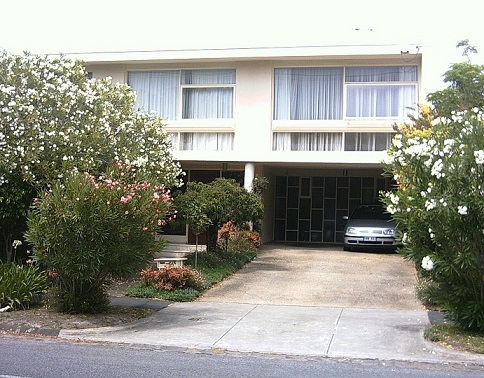On
the strength of prior experience with the design of high-rise apartment
blocks in Berlin, Feldhagen secured a position with the Housing Commission of Victoria,
which, at that time, was starting its own regime of multi-storey public
housing. By 1960, however, he had
left to take a position in the office of fellow European émigré architect
Ernest Fooks (1906-1985). Migrating from
Austria (via Canada) in 1939, Fooks had also once worked for the Housing
Commission before opening his own office in 1949. By the time that Feldhagen joined him, Fooks was well established as one of the leading architects to Melbourne's
thriving post-war Jewish migrant community.
A number of Fooks’ clients, impressed by Feldhagen’s speed and
efficiency, urged him to start his own practice. Perhaps discouraged by reports
from other migrant architects (perhaps even Fooks himself) that their overseas
qualifications were not instantly recognized by the Architects’ Registration
Board of Victoria, Feldhagen did not attempt to become registered himself.
Instead, with a client base already developing, he simply opted to style
himself, for legal purposes, as an ‘architectural designer’.
Established by 1963, Feldhagen’s practice was initially based in Acland Street, St Kilda, but later moved to Darling Street, South Yarra and later still to Shakespeare Grove, St Kilda. In 1967, he re-configured his business as a public company, M Feldhagen & Associates Pty Ltd. His early output included a number of small factories, but he soon established a reputation as a designer of large houses, including the private residences of a number of Jewish builders with whom he regularly worked. Feldhagen frequently collaborated with fellow European émigré professionals, including engineers David Shalit and Pento Stojanoff, while his own office staff included young architectural students of Asian and Turkish descent.
From the late 1960s, when changes to strata title legislation prompted a boom in apartment construction, Feldhagen became one of the leading exponents of the type. During the years 1968-69 alone, eight examples of his multiple-dwelling projects were published in the property columns of the Herald and Age newspapers. Seeking to diversify his business, Feldhagen decided to expand into building works and, in May 1970, formed a second company, M Feldhagen Constructions Pty Ltd. Around the same time, he acquired a fire-damaged house on Mount Dandenong Road, Kilsyth (formerly owned by the sculptor Norma Redpath), which he extensively rebuilt and renovated as his own family residence.
During the 1970s, Feldhagen
continue to thrive as both a designer and a builder, maintaining earlier
associations with migrant property developers. However, as the decade wore on,
commissions from those sources began to dwindle. Feldhagen declared bankruptcy in 1975, and
his two public companies were subsequently de-listed. Nevertheless, he resumed
practice as an architectural designer, with his teenage son as his draftsman
and sole employee. The practice continued into the 1980s under the name of
Michol Designs (ie combination of the forenames of Feldhagen and his son). One of Feldhagen’s most notable projects from
this later period was a church in Chirnside Park, which opened in 1986.
Feldhagen retired to Queensland in the 1990s and died there on 21 January 2013, aged 80 years.
Select List of Projects
| 1963 1964 1965 1967 1968 1969 1970 | Alterations to factory for Hosma Shirts, Nicholson Street, Fitzroy Block of flats (duplex) for H Barr, Doncaster Road, Balwyn Block of flats for S Hornung, Millswyn Street, South Yarra Residence for E Hellinger, 656 Orrong Road, Toorak Residence for I Wise, 30 Aroona Road, Caulfield North Factory for Mainline Properties, Cubitt Street, Richmond Residence for J Widawski, Dendy Street, Brighton Block of flats (duplex) for J Wenborn, Beach Road, Black Rock Factory for Mac's Shortbread Company, Canterbury Road, Surrey Hills [demolished] Block of flats, Malvern Road, Armadale Two blocks of flats, Power Street, Hawthorn Residence for Dr S Chazan, Raheen Drive, Kew Residence for self, Mount Dandenong Road, Kilsyth Block of flats, Liverpool Road, Kilsyth Block of flats, Garden Road, Kilsyth |
 | |
| Michael R E Feldhagen in the late 1950s |
 | |
| Widawski House, Dendy Street, Brighton (1965) (source: photograph by Simon Reeves, 2007) |
 | |
| Wenborn flats, Beach Road, Black Rock (1965) |
 | |
| Block of flats, Power Street, Hawthorn (1968) (source: photograph by Simon Reeves, 2015) |
| Acknowledgement Special thanks to the Feldhagen family for providing additional biographical details. |
top
